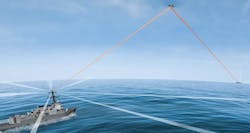Navy asks L3Harris to provide signal data processing for shipboard network that blends sensors and weapons
WASHINGTON – U.S. Navy surface warfare experts needed signal data processors and spare parts for the Cooperative Engagement Capability (CEC) tactical network aboard Navy surface warships. They found their solution from L3Harris Technologies.
Officials of the Naval Sea Systems Command in Washington announced a $32 million order last week to the L3Harris C5 Integrated Systems segment in Camden, N.J., for CEC spares and signal data processors.
The CEC is a maritime tactical sensor and weapons network for anti-air warfare that combines information from sensors on aircraft and surface vessels that are operating over broadly distributed geographic areas.
CEC combines sensor information into a common tactical picture for battle groups at sea. It improves overall situational awareness, and enables fleet commanders to work closely together to attack enemy forces from long ranges.
The order to L3Harris is a modification to a six-year $14.9 million contract the company won last July for CEC system production and repair. This contract has options that could increase its value to $378.9 million.
CEC blends sensors and weapons into a integrated real-time network that expands the battlespace; enhances situational awareness; increases depth of fire; enables long intercept ranges; and improves decision and reaction times.
It extracts and distributes sensor information such that the superset of this data is available to all participating CEC-equipped units by fusing the distributed data from shipboard, airborne, composite tracking network ground-mobile units, Joint Land Attack Cruise Missile Defense Elevated Netted Sensor System (JLENS), and coalition partners into one fire-control-quality air track picture.
The system uses line-of-sight data distribution to share radar-measurement data among sensors and weapons to create one distributed integrated air picture. It combines surveillance and targeting information such that the combined system is greater than the sum of its parts.
The jam-resistant CEC obtains target track information to form one real-time composite track to help coordinate theater air and missile defense to engage incoming cruise missiles.
CEC consists of the Data Distribution System (DDS), the Cooperative Engagement Processor (CEP), and interface with combat systems and sensors.
The DDS encodes and distributes own-ship sensor and engagement data. The CEP processes force levels of data in near real-time, and enables surface warships and other weapons platforms to can cue their onboard sensors and weapons to engage targets without actually tracking them.
On this order L3Harris will do the work in Lititz and Lancaster, Pa.; Salt Lake City; and Largo, Fla., and should be finished by April 2023. For more information contact L3Harris C5 Integrated Systems online at www.l3harris.com, or Naval Sea Systems Command at www.navsea.navy.mil.
About the Author
John Keller
Editor-in-Chief
John Keller is the Editor-in-Chief, Military & Aerospace Electronics Magazine--provides extensive coverage and analysis of enabling electronics and optoelectronic technologies in military, space and commercial aviation applications. John has been a member of the Military & Aerospace Electronics staff since 1989 and chief editor since 1995.
